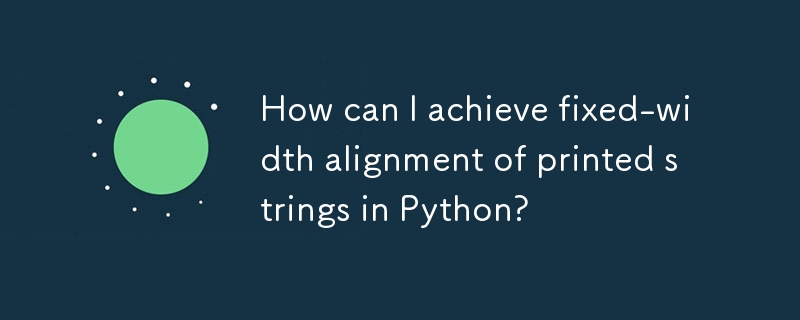如何在Python中實現列印字串的固定寬度對齊?
- Linda Hamilton原創
- 2024-11-05 22:32:02924瀏覽

以固定寬度對齊方式列印字串
在程式設計中,為了清晰和視覺組織,通常需要在固定列中對齊字串。本文探討如何使用 Python 中的高階格式化技術來實現此目的。
問題:對齊不均勻的字串值
考慮以下程式碼,程式碼計算給定字串中所有排列的頻率:
# Original code to generate permutations
...
# Printing results
unique = sorted(set(el))
for prefix in unique:
if prefix != "":
print("value ", prefix, "- num of occurrences = ", string.count(str(prefix)))
但是,由於字串長度不同,輸出可能會出現未對齊的情況:
value a - num of occurrences = 1 value ab - num of occurrences = 1 value abc - num of occurrences = 1 value b - num of occurrences = 1 value bc - num of occurrences = 1 value bcd - num of occurrences = 1 value c - num of occurrences = 1 value cd - num of occurrences = 1 value d - num of occurrences = 1
使用str.format的解決方案
要對齊輸出,我們可以使用str具有特定格式說明符的.format 方法:
# Using str.format for alignment
print("{0: <5}".format("value ") +
"{1: >15}".format(prefix) +
"- num of occurrences = " +
"{2: <5}".format(string.count(str(prefix))))格式說明符:
- <5:左對齊字串5 個字元寬度內。
- >15:在 15 個字元寬度內右對齊字串。
編輯 1: 「{0: <5}」中的「0」指的是傳遞給 str.format() 的參數的索引。
編輯2:Python 3 引入f-string 作為str.format 的簡潔替代品:
# Using f-strings for alignment
print(f"{'value ':<5}" +
f"{prefix:>15}" +
"- num of occurrences = " +
f"{string.count(str(prefix)):<5}")
優點:
- 增強可讀性和組織性。
- 靈活性指定對齊方式和寬度。
- 與 Python 2 和 Python 3 的兼容性。
以上是如何在Python中實現列印字串的固定寬度對齊?的詳細內容。更多資訊請關注PHP中文網其他相關文章!
陳述:
本文內容由網友自願投稿,版權歸原作者所有。本站不承擔相應的法律責任。如發現涉嫌抄襲或侵權的內容,請聯絡admin@php.cn

